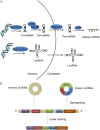Non-coding RNAs: emerging regulators of glucose metabolism in hepatocellular carcinoma
- PMID: 33414986
- PMCID: PMC7783776
Non-coding RNAs: emerging regulators of glucose metabolism in hepatocellular carcinoma
Abstract
Reprogramming of metabolism is one of the hallmarks of cancer, among which glucose metabolism dysfunction is the most prominent feature. The glucose metabolism of tumor cells is significantly different from that of normal cells. Glucose metabolism reprogramming of hepatocellular carcinoma (HCC) has become an important research hotspot in the field of HCC, a variety of tumor metabolic interventions have been applied clinically. Moreover, various Non-coding RNAs (ncRNAs) including microRNAs (miRNAs), long non-coding (lncRNAs) as well as circular RNAs (circRNAs), have recently been proved to play potential roles in glucose metabolism. This review summarizes the effects of ncRNAs on HCC that participate in glucose metabolism and discuss the related mechanisms to find potential and effective targeted treatments for HCC.
Keywords: Hepatocellular carcinoma; circular RNAs; glucose metabolism; glycolysis; long non-coding RNAs; microRNAs; non-coding RNA.
AJCR Copyright © 2020.
Conflict of interest statement
None.
Figures



Similar articles
-
Non-coding RNAs: Emerging Regulators of Sorafenib Resistance in Hepatocellular Carcinoma.Front Oncol. 2019 Nov 5;9:1156. doi: 10.3389/fonc.2019.01156. eCollection 2019. Front Oncol. 2019. PMID: 31750247 Free PMC article. Review.
-
The Underlying Mechanisms of Noncoding RNAs in the Chemoresistance of Hepatocellular Carcinoma.Mol Ther Nucleic Acids. 2020 Sep 4;21:13-27. doi: 10.1016/j.omtn.2020.05.011. Epub 2020 May 15. Mol Ther Nucleic Acids. 2020. PMID: 32505000 Free PMC article. Review.
-
Emerging roles of non-coding RNAs in the metabolic reprogramming of tumor-associated macrophages.Immunol Lett. 2021 Apr;232:27-34. doi: 10.1016/j.imlet.2021.02.003. Epub 2021 Feb 9. Immunol Lett. 2021. PMID: 33577913 Review.
-
The emerging regulatory roles of non-coding RNAs associated with glucose metabolism in breast cancer.Semin Cancer Biol. 2023 Oct;95:1-12. doi: 10.1016/j.semcancer.2023.06.007. Epub 2023 Jun 25. Semin Cancer Biol. 2023. PMID: 37364663 Review.
-
The Role of Non-Coding RNAs in the Sorafenib Resistance of Hepatocellular Carcinoma.Front Oncol. 2021 Jul 22;11:696705. doi: 10.3389/fonc.2021.696705. eCollection 2021. Front Oncol. 2021. PMID: 34367979 Free PMC article. Review.
Cited by
-
Lnc-SNHG5 Promoted Hepatocellular Carcinoma Progression Through the RPS3-NFκB Pathway.Int J Gen Med. 2023 Dec 1;16:5651-5664. doi: 10.2147/IJGM.S442937. eCollection 2023. Int J Gen Med. 2023. PMID: 38059157 Free PMC article.
-
Cancer Stem Cells and the Tumor Microenvironment in Gastric Cancer.Front Oncol. 2022 Jan 3;11:803974. doi: 10.3389/fonc.2021.803974. eCollection 2021. Front Oncol. 2022. PMID: 35047411 Free PMC article. Review.
-
DNAAF5 promotes hepatocellular carcinoma malignant progression by recruiting USP39 to improve PFKL protein stability.Front Oncol. 2022 Oct 6;12:1032579. doi: 10.3389/fonc.2022.1032579. eCollection 2022. Front Oncol. 2022. PMID: 36276075 Free PMC article.
-
Analysis of the expression, function and signaling of glycogen phosphorylase isoforms in hepatocellular carcinoma.Oncol Lett. 2022 Jun 7;24(2):244. doi: 10.3892/ol.2022.13364. eCollection 2022 Aug. Oncol Lett. 2022. PMID: 35761940 Free PMC article.
-
Novel phloretin-based combinations targeting glucose metabolism in hepatocellular carcinoma through GLUT2/PEPCK axis of action: in silico molecular modelling and in vivo studies.Med Oncol. 2023 Dec 11;41(1):12. doi: 10.1007/s12032-023-02236-x. Med Oncol. 2023. PMID: 38078989
References
-
- Bray F, Ferlay J, Soerjomataram I, Siegel RL, Torre LA, Jemal A. Global cancer statistics 2018: GLOBOCAN estimates of incidence and mortality worldwide for 36 cancers in 185 countries. CA Cancer J Clin. 2018;68:394–424. - PubMed
-
- Maluccio M, Covey A. Recent progress in understanding, diagnosing, and treating hepatocellular carcinoma. CA Cancer J Clin. 2012;62:394–399. - PubMed
-
- Heimbach JK, Kulik LM, Finn RS, Sirlin CB, Abecassis MM, Roberts LR, Zhu AX, Murad MH, Marrero JA. AASLD guidelines for the treatment of hepatocellular carcinoma. Hepatology. 2018;67:358–380. - PubMed
Publication types
LinkOut - more resources
Full Text Sources
